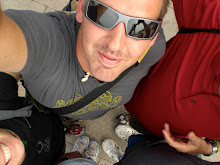But that doesn't satisfy me. It is a mark, and a hybrid, like the rest of us. If I have learned anything, or gleaned something that maybe I wasn't supposed to learn, it is this: A thought, about anything, even something as insignificant as punctuation can reflect something else that has more power to drive us, our society, the world. A living metaphor. Allegory. You pick.
A philosopher named Sassure suggested language, words--these words, any words--exist always in a system of differences without positive terms. That is, the words can never be identified by what they are, but by everything they are not. Through just a small part of the 20th century, other thinkers came up with different ways to apply this principle. It became a tool in the kits used by scholars, feminists, individuals. Jaques Derrida, along with giving us all a good mind-thrashing, took this idea and played with it--yes played. He calls that play Différance, and he said it is the stone that is close to signifying the death of the dynasty. Derrida's meaning is the dynasty (the traditional search for authoritative meaning) and no one can tell you exactly what he means by that statement because the words do not specify exact meaning, only differences, therefore the play therein is the stone. What a great challenge and charge to a person: What you think matters. In this way, I come to the interrobang.
Let's go back to the calloused girl with the fancy phone. What if she's not trying to express uncertainty, surprise and confusion? Say, she'd like to express disbelief and anger instead. Well, the interrobang is just fine for that, too. It plays with the way we use both the question and exclamation marks, only now it is played with and mashed into one funny looking mark. Refer to différance a few lines up.
In a sense, this mark is a syntax cyborg--not question mark, not an exclamation mark, but having characteristics of both, yet not fully either. There is no way of getting around this: If we follow our philosophical bread trail, we meet Donna Haraway and do actually land on the topic of cyborgs in their very own manifesto. After all, cyborgs are people, too. And other stuff. And who should tell them what they are or are not? Do they not deserve rights like us?
If we can think of the interrobang as a cyborg, can we also think of people like an interrobang? We are all hybrids. Mechanic+student+drinking partner+dog owner+motorcycle rider+writer+sweetheart+royal pain in the ass+etc=me. How about you? Seems we might all have a bit of the interrobang inside us. And maybe through some oddball reverse engineering, the use of interrobang signifies our cultural realization and embracing of our true and complicated natures.
So, my new friend the interrobang gets some credit. But, here's the rub: In order to make the mark on this page, I have to switch the language on my computer and perform a key stroke that involves pressing 5 more keys in sequence. Could it get any harder to use this little bastard‽ I don't have to spell out that irony for you, do I? Someone talk to The Man and tell him that the rest of us hybrids are running the show now.

too funny. that's my new favorite thing now. I had seen something about it years ago but didn't have a blog to use it on - much less fun in my hardcopy journal. there is an upsidedown one for spanish, too, according to wikipedia...
ReplyDeleteBut now we can all cut-and-paste from yours! : )
ReplyDelete